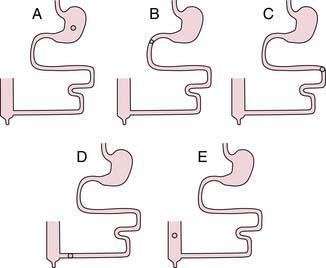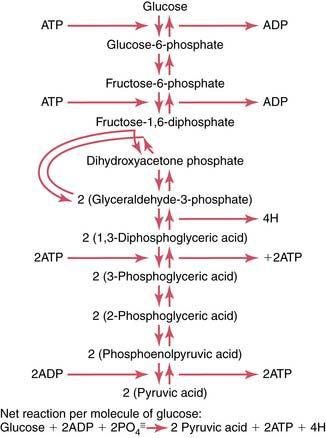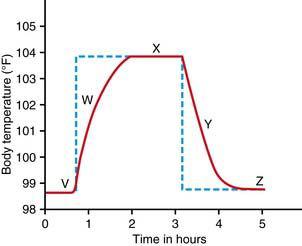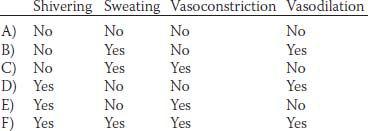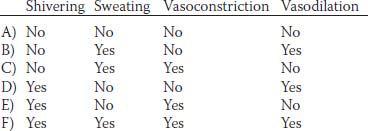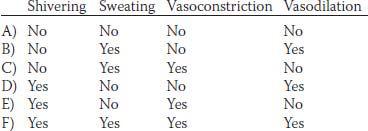3. A 54-year-old man consumes a meal containing a large amount of fat. At which of the locations in the following figure is bile salts most likely to be absorbed by an active transport process?
4. A 69-year-old woman has a 30-year history of alcoholism and liver disease. She visits her physician because of swelling in the abdomen. An increase in which of the following is the most likely cause of the ascites?
5. The first stage in using triglycerides for energy is hydrolysis of the triglycerides to which of the following substance(s)?
6. Most of the heat loss from an unclothed person at room temperature occurs by which of the following mechanisms?
7. The increase in serum bilirubin levels in patients with alcoholic cirrhosis most often results from which of the following?
8. A 65-year-old man has a 25-year history of alcoholism and liver disease. He visits his physician because of swelling in his legs. A decrease in which of the following is likely to contribute to the development of edema in his legs?
9. A 45-year-old African-American man is admitted to the emergency department because of upper right quadrant pain. The man has a history of sickle-cell disease. Laboratory tests show that plasma bilirubin levels are three times greater compared to normal. Ultrasound studies confirm the presence of gallstones. Which of the following is the most likely composition of the gallstones in this patient?
Refer to the following figure to answer questions 10 and 11.
10. Abundant amounts of adenosine triphosphate (ATP) in the cytoplasm of the cell inhibit which of the following steps in glycolysis?
11. Abundant amounts of adenosine diphosphate (ADP) or adenosine monophosphate (AMP) stimulate which of the following steps in glycolysis?
12. The transport of glucose through the membranes of most tissue cells occurs by which of the following processes?
13. Which of the following mechanisms causes heat loss from a normal person when the environmental temperature is 106°F and the relative humidity is less than 10%?
14. About 75% of the blood flowing through the liver is from the portal vein, and the remainder is from the hepatic artery during resting conditions. Which of the following best describes the liver circulation in terms of resistance, pressure, and flow?
15. A scuba diver explores an underwater lava flow where the water temperature is 102°F. Which of the following profiles best describes the mechanisms of heat loss that are effective in this man?
16. A 57-year-old obese woman on hormone replacement therapy develops gallstones. Her gallstones are most likely composed of which of the following substances?
17. Deamination means removal of the amino groups from the amino acids. Which of the following substances is produced when deamination occurs by transamination?
18. Most of the energy released from the glucose molecule occurs by which of the following processes?
19. A 30-year-old man runs on an inclined treadmill until near exhaustion for an experiment examining anaerobic exercise conditioning. All of the following statements concerning the conversion of pyruvic acid to lactic under anaerobic conditions are true EXCEPT one. Which one is this EXCEPTION?
A) Conversion of pyruvic acid to lactic acid provides a sinkhole into which the end-products of glycolysis can disappear
C) The NAD+ produced by the conversion of pyruvic acid to lactic acid can combine with two hydrogen atoms and allow glycolysis to continue
20. A 45-year-old man is admitted to the emergency department after he was found lying in the street in an inebriated state. He is markedly pale with icteric conjunctivae and skin. His abdomen is distended, and there is shifting dullness, indicating ascites. The liver is enlarged about 5 centimeters below the right costal margin and tender. The spleen cannot be palpated. There is bilateral edema of his legs and feet. Which of the following values of direct and indirect bilirubin (in milligrams per deciliter) are most likely to be present in this man’s plasma?
| Direct | Indirect | |
|---|---|---|
| A) | 1.1 | 1.2 |
| B) | 1.7 | 5.4 |
| C) | 2.4 | 2.5 |
| D) | 5.2 | 1.8 |
| E) | 5.8 | 7.2 |
Use the following figure to answer questions 21 to 23. The diagram shows the effects of changing the set-point of the hypothalamic temperature controller. The red line indicates the body temperature, and the blue line represents the hypothalamic set-point temperature.
24. Which of the following is the most abundant source of high-energy phosphate bonds in the cells?




Stay updated, free articles. Join our Telegram channel

Full access? Get Clinical Tree


